Evaluating Pay for Performance in Human Resource Management (HRM)
VerifiedAdded on 2023/05/30
|8
|1402
|204
Report
AI Summary
This report examines the effectiveness of pay for performance within human resource management, drawing upon existing literature to explore the relationship between compensation systems and employee performance. It discusses various theories, such as reinforcement and expectancy theory, and the efficiency wage theory, to understand how pay influences employee motivation, job satisfaction, and turnover rates. The report also highlights the importance of designing appropriate incentive plans based on job positions, ranging from recognition for junior employees to profit sharing for senior management. Ultimately, it emphasizes the need for HR managers to develop efficient compensation systems to optimize workforce performance and achieve market competitiveness. Desklib offers this assignment solution and many more resources for students.

HUMAN RESOURCE MANAGEMENT –
878846
878846
Paraphrase This Document
Need a fresh take? Get an instant paraphrase of this document with our AI Paraphraser
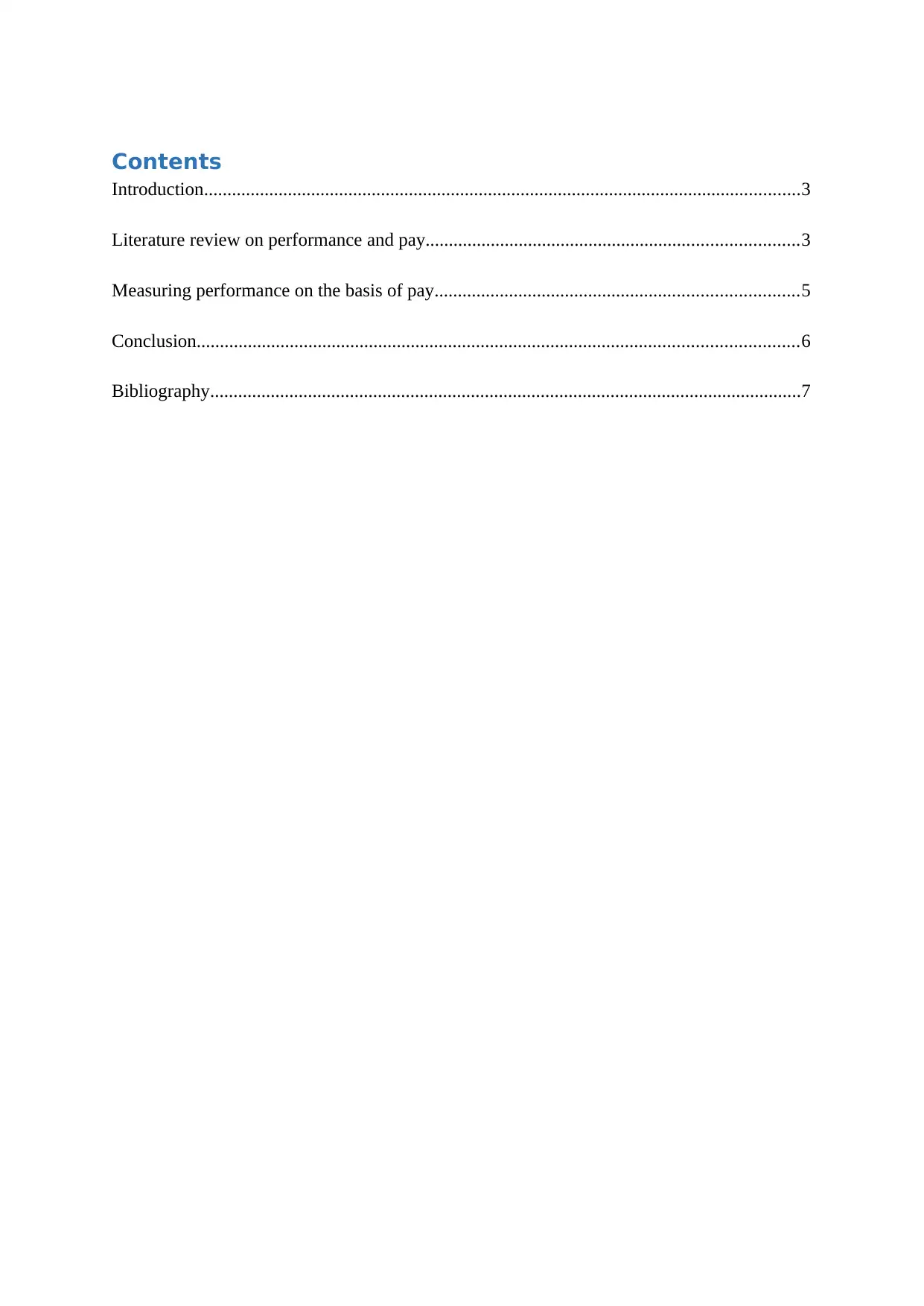
Contents
Introduction................................................................................................................................3
Literature review on performance and pay................................................................................3
Measuring performance on the basis of pay..............................................................................5
Conclusion.................................................................................................................................6
Bibliography...............................................................................................................................7
Introduction................................................................................................................................3
Literature review on performance and pay................................................................................3
Measuring performance on the basis of pay..............................................................................5
Conclusion.................................................................................................................................6
Bibliography...............................................................................................................................7
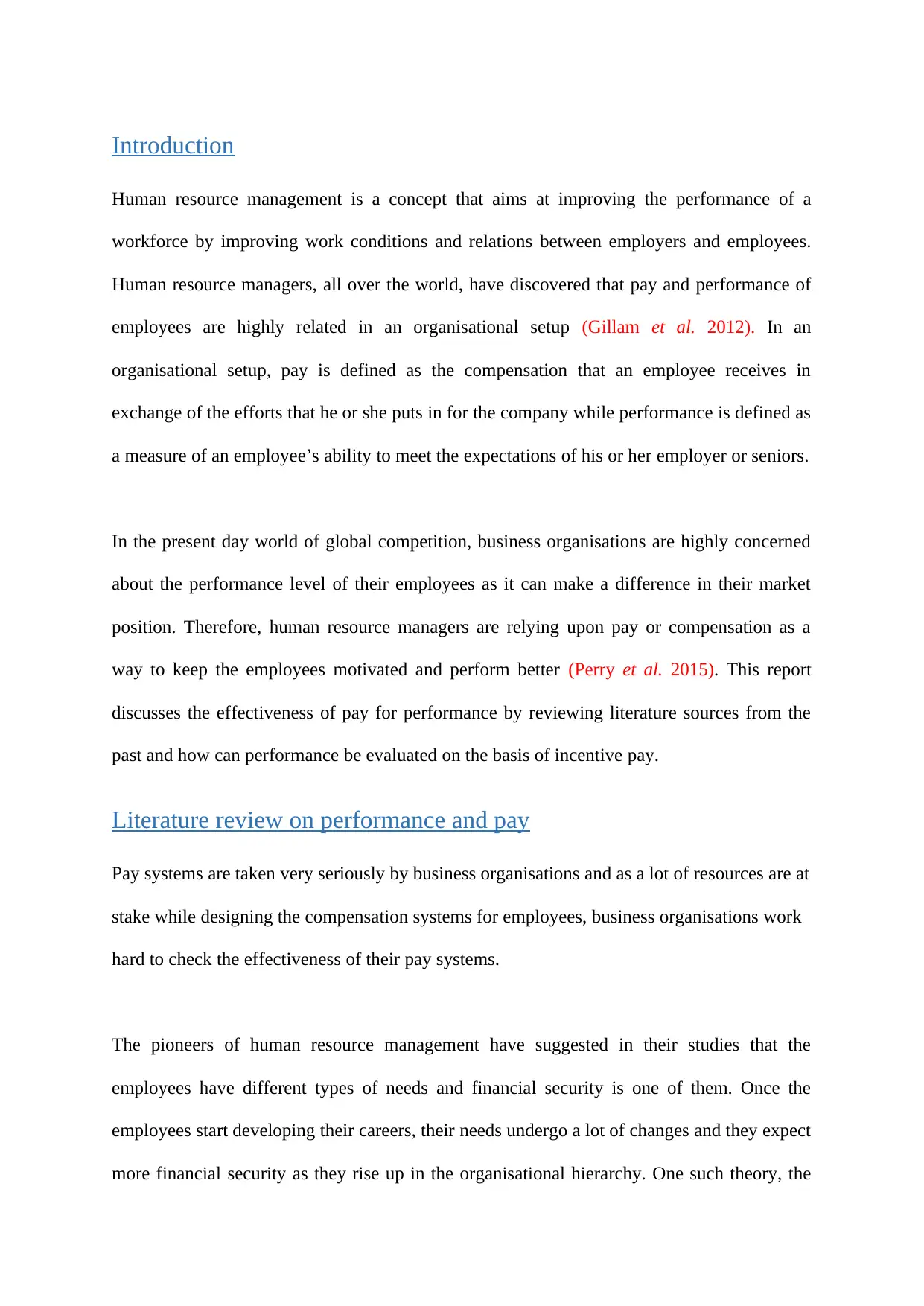
Introduction
Human resource management is a concept that aims at improving the performance of a
workforce by improving work conditions and relations between employers and employees.
Human resource managers, all over the world, have discovered that pay and performance of
employees are highly related in an organisational setup (Gillam et al. 2012). In an
organisational setup, pay is defined as the compensation that an employee receives in
exchange of the efforts that he or she puts in for the company while performance is defined as
a measure of an employee’s ability to meet the expectations of his or her employer or seniors.
In the present day world of global competition, business organisations are highly concerned
about the performance level of their employees as it can make a difference in their market
position. Therefore, human resource managers are relying upon pay or compensation as a
way to keep the employees motivated and perform better (Perry et al. 2015). This report
discusses the effectiveness of pay for performance by reviewing literature sources from the
past and how can performance be evaluated on the basis of incentive pay.
Literature review on performance and pay
Pay systems are taken very seriously by business organisations and as a lot of resources are at
stake while designing the compensation systems for employees, business organisations work
hard to check the effectiveness of their pay systems.
The pioneers of human resource management have suggested in their studies that the
employees have different types of needs and financial security is one of them. Once the
employees start developing their careers, their needs undergo a lot of changes and they expect
more financial security as they rise up in the organisational hierarchy. One such theory, the
Human resource management is a concept that aims at improving the performance of a
workforce by improving work conditions and relations between employers and employees.
Human resource managers, all over the world, have discovered that pay and performance of
employees are highly related in an organisational setup (Gillam et al. 2012). In an
organisational setup, pay is defined as the compensation that an employee receives in
exchange of the efforts that he or she puts in for the company while performance is defined as
a measure of an employee’s ability to meet the expectations of his or her employer or seniors.
In the present day world of global competition, business organisations are highly concerned
about the performance level of their employees as it can make a difference in their market
position. Therefore, human resource managers are relying upon pay or compensation as a
way to keep the employees motivated and perform better (Perry et al. 2015). This report
discusses the effectiveness of pay for performance by reviewing literature sources from the
past and how can performance be evaluated on the basis of incentive pay.
Literature review on performance and pay
Pay systems are taken very seriously by business organisations and as a lot of resources are at
stake while designing the compensation systems for employees, business organisations work
hard to check the effectiveness of their pay systems.
The pioneers of human resource management have suggested in their studies that the
employees have different types of needs and financial security is one of them. Once the
employees start developing their careers, their needs undergo a lot of changes and they expect
more financial security as they rise up in the organisational hierarchy. One such theory, the
⊘ This is a preview!⊘
Do you want full access?
Subscribe today to unlock all pages.

Trusted by 1+ million students worldwide
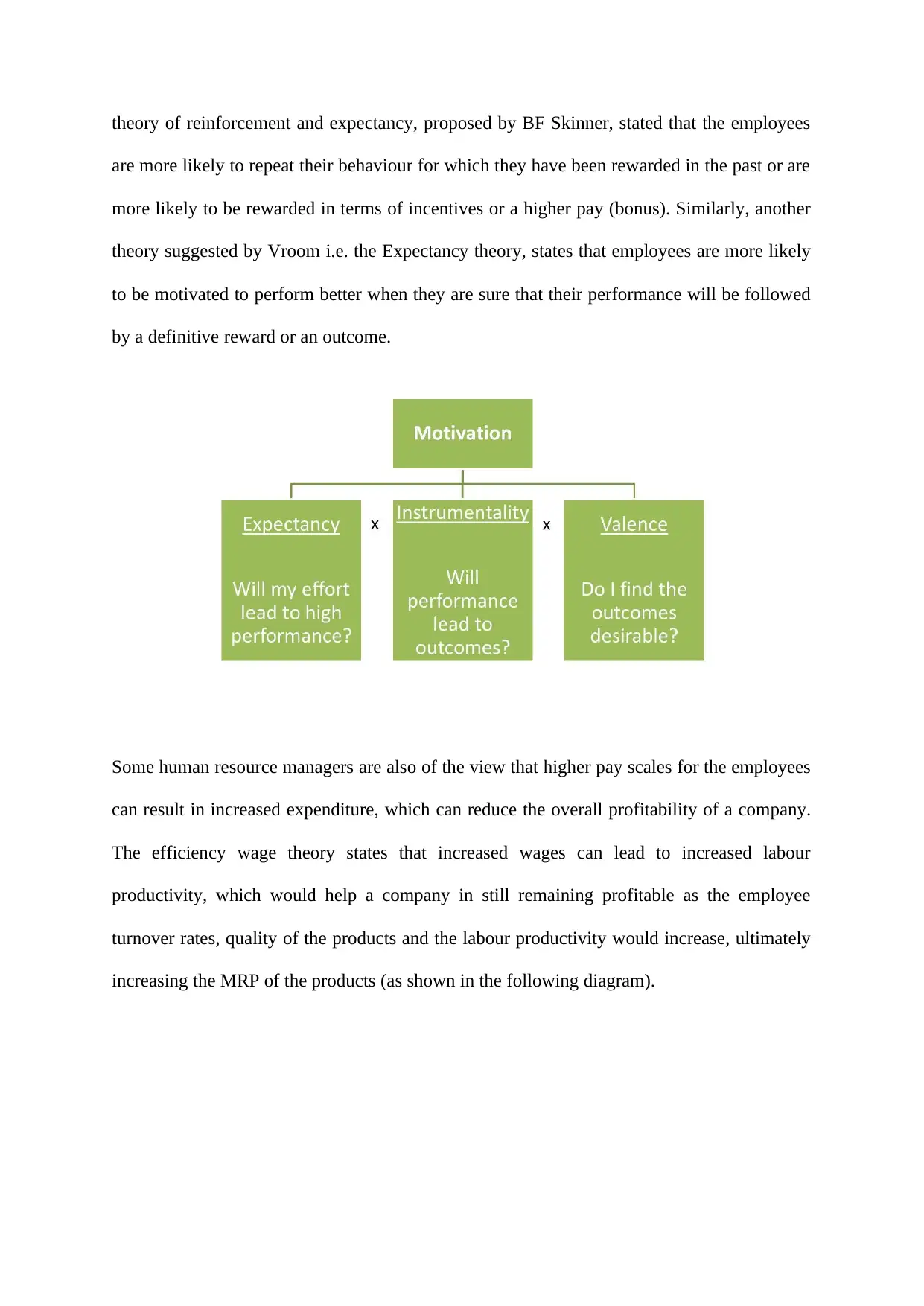
theory of reinforcement and expectancy, proposed by BF Skinner, stated that the employees
are more likely to repeat their behaviour for which they have been rewarded in the past or are
more likely to be rewarded in terms of incentives or a higher pay (bonus). Similarly, another
theory suggested by Vroom i.e. the Expectancy theory, states that employees are more likely
to be motivated to perform better when they are sure that their performance will be followed
by a definitive reward or an outcome.
Some human resource managers are also of the view that higher pay scales for the employees
can result in increased expenditure, which can reduce the overall profitability of a company.
The efficiency wage theory states that increased wages can lead to increased labour
productivity, which would help a company in still remaining profitable as the employee
turnover rates, quality of the products and the labour productivity would increase, ultimately
increasing the MRP of the products (as shown in the following diagram).
are more likely to repeat their behaviour for which they have been rewarded in the past or are
more likely to be rewarded in terms of incentives or a higher pay (bonus). Similarly, another
theory suggested by Vroom i.e. the Expectancy theory, states that employees are more likely
to be motivated to perform better when they are sure that their performance will be followed
by a definitive reward or an outcome.
Some human resource managers are also of the view that higher pay scales for the employees
can result in increased expenditure, which can reduce the overall profitability of a company.
The efficiency wage theory states that increased wages can lead to increased labour
productivity, which would help a company in still remaining profitable as the employee
turnover rates, quality of the products and the labour productivity would increase, ultimately
increasing the MRP of the products (as shown in the following diagram).
Paraphrase This Document
Need a fresh take? Get an instant paraphrase of this document with our AI Paraphraser
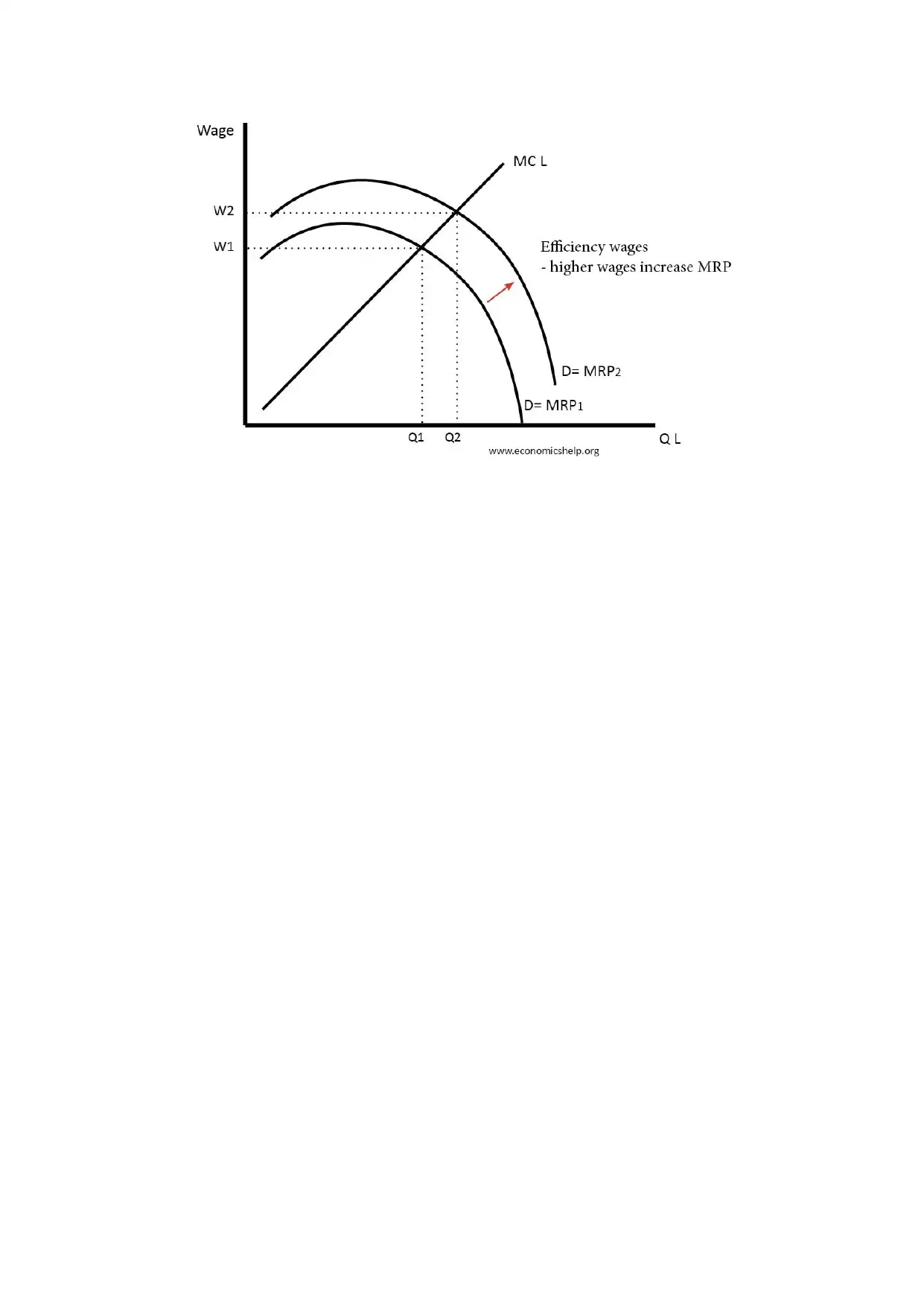
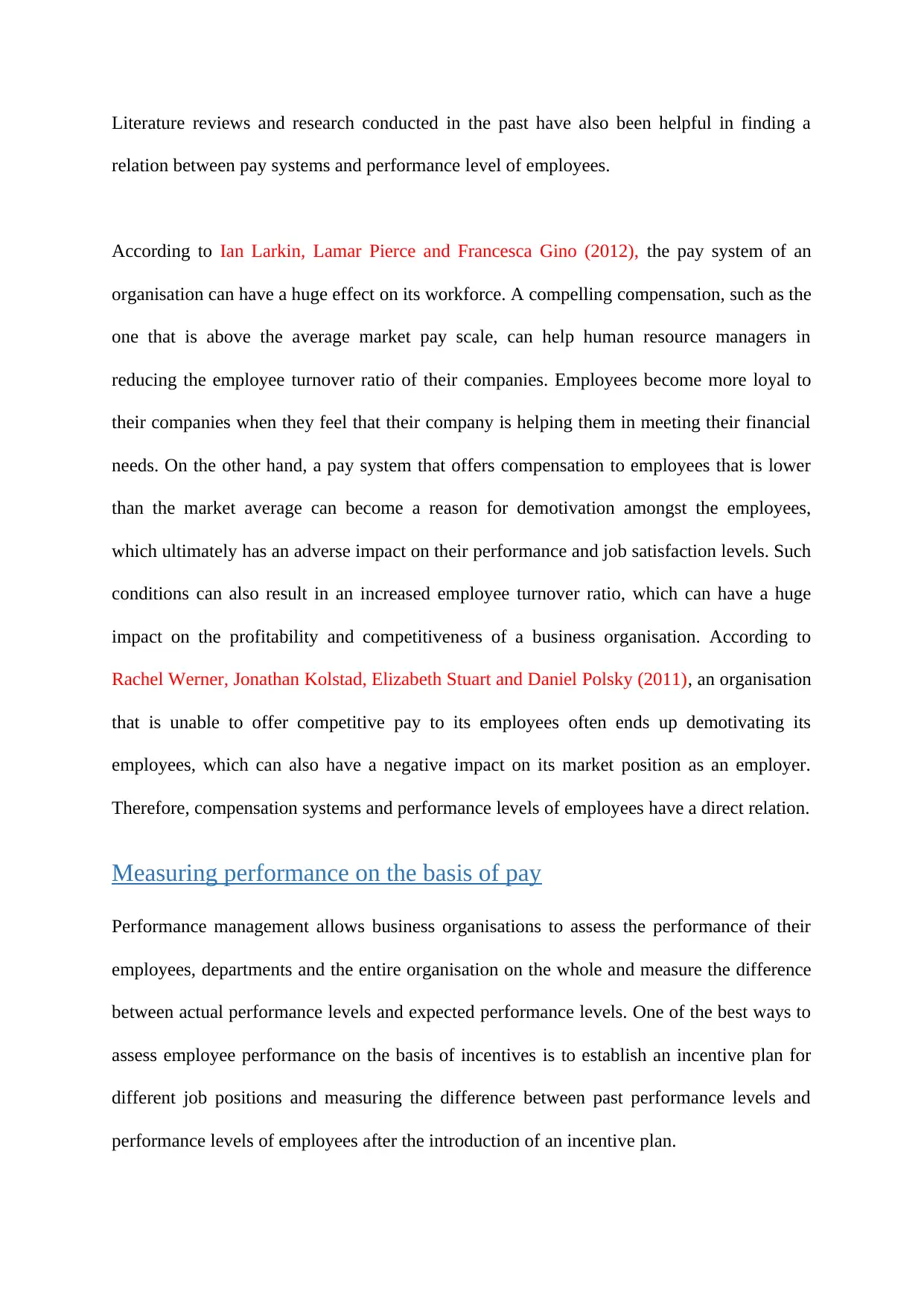
Literature reviews and research conducted in the past have also been helpful in finding a
relation between pay systems and performance level of employees.
According to Ian Larkin, Lamar Pierce and Francesca Gino (2012), the pay system of an
organisation can have a huge effect on its workforce. A compelling compensation, such as the
one that is above the average market pay scale, can help human resource managers in
reducing the employee turnover ratio of their companies. Employees become more loyal to
their companies when they feel that their company is helping them in meeting their financial
needs. On the other hand, a pay system that offers compensation to employees that is lower
than the market average can become a reason for demotivation amongst the employees,
which ultimately has an adverse impact on their performance and job satisfaction levels. Such
conditions can also result in an increased employee turnover ratio, which can have a huge
impact on the profitability and competitiveness of a business organisation. According to
Rachel Werner, Jonathan Kolstad, Elizabeth Stuart and Daniel Polsky (2011), an organisation
that is unable to offer competitive pay to its employees often ends up demotivating its
employees, which can also have a negative impact on its market position as an employer.
Therefore, compensation systems and performance levels of employees have a direct relation.
Measuring performance on the basis of pay
Performance management allows business organisations to assess the performance of their
employees, departments and the entire organisation on the whole and measure the difference
between actual performance levels and expected performance levels. One of the best ways to
assess employee performance on the basis of incentives is to establish an incentive plan for
different job positions and measuring the difference between past performance levels and
performance levels of employees after the introduction of an incentive plan.
relation between pay systems and performance level of employees.
According to Ian Larkin, Lamar Pierce and Francesca Gino (2012), the pay system of an
organisation can have a huge effect on its workforce. A compelling compensation, such as the
one that is above the average market pay scale, can help human resource managers in
reducing the employee turnover ratio of their companies. Employees become more loyal to
their companies when they feel that their company is helping them in meeting their financial
needs. On the other hand, a pay system that offers compensation to employees that is lower
than the market average can become a reason for demotivation amongst the employees,
which ultimately has an adverse impact on their performance and job satisfaction levels. Such
conditions can also result in an increased employee turnover ratio, which can have a huge
impact on the profitability and competitiveness of a business organisation. According to
Rachel Werner, Jonathan Kolstad, Elizabeth Stuart and Daniel Polsky (2011), an organisation
that is unable to offer competitive pay to its employees often ends up demotivating its
employees, which can also have a negative impact on its market position as an employer.
Therefore, compensation systems and performance levels of employees have a direct relation.
Measuring performance on the basis of pay
Performance management allows business organisations to assess the performance of their
employees, departments and the entire organisation on the whole and measure the difference
between actual performance levels and expected performance levels. One of the best ways to
assess employee performance on the basis of incentives is to establish an incentive plan for
different job positions and measuring the difference between past performance levels and
performance levels of employees after the introduction of an incentive plan.
⊘ This is a preview!⊘
Do you want full access?
Subscribe today to unlock all pages.

Trusted by 1+ million students worldwide
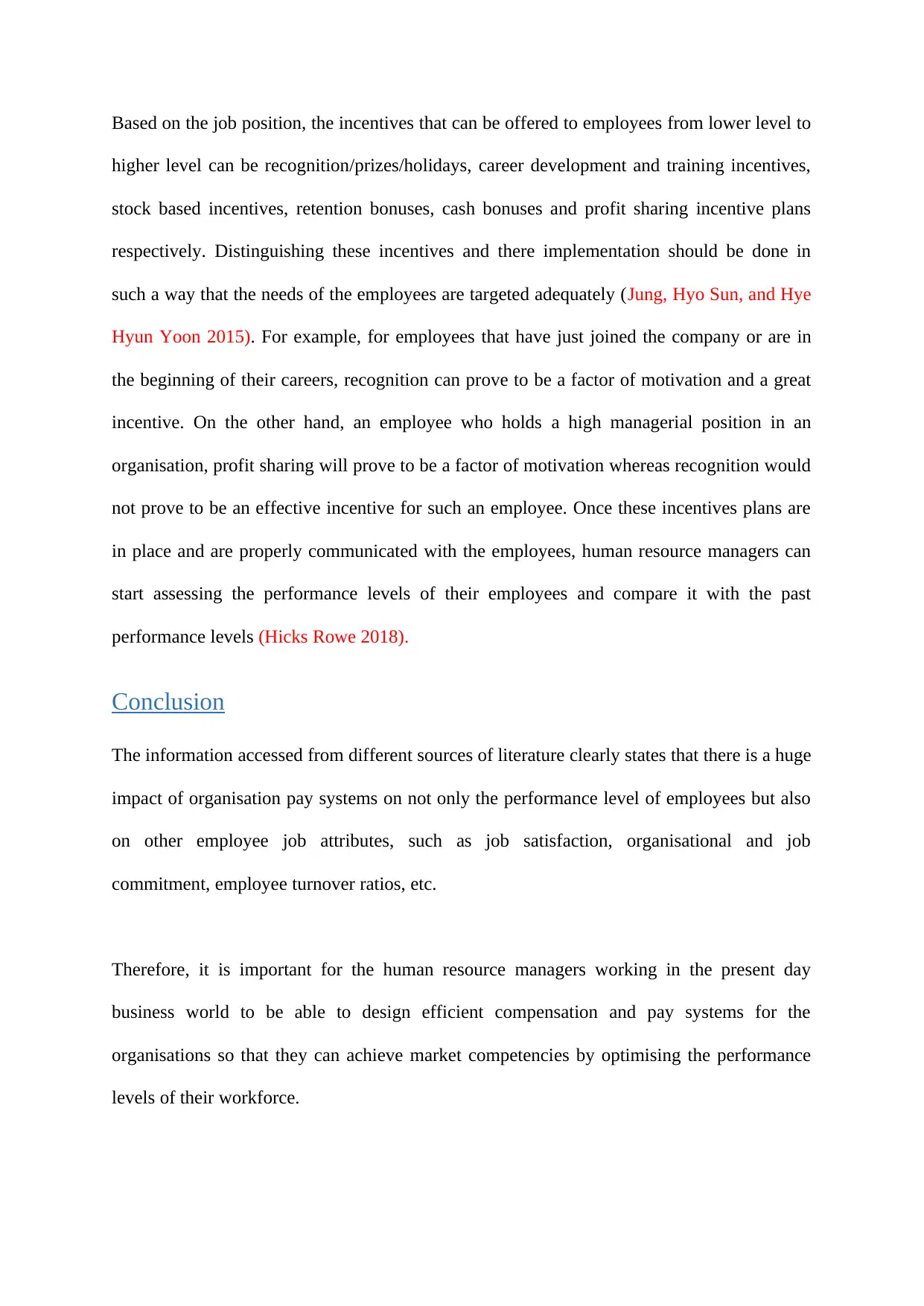
Based on the job position, the incentives that can be offered to employees from lower level to
higher level can be recognition/prizes/holidays, career development and training incentives,
stock based incentives, retention bonuses, cash bonuses and profit sharing incentive plans
respectively. Distinguishing these incentives and there implementation should be done in
such a way that the needs of the employees are targeted adequately (Jung, Hyo Sun, and Hye
Hyun Yoon 2015). For example, for employees that have just joined the company or are in
the beginning of their careers, recognition can prove to be a factor of motivation and a great
incentive. On the other hand, an employee who holds a high managerial position in an
organisation, profit sharing will prove to be a factor of motivation whereas recognition would
not prove to be an effective incentive for such an employee. Once these incentives plans are
in place and are properly communicated with the employees, human resource managers can
start assessing the performance levels of their employees and compare it with the past
performance levels (Hicks Rowe 2018).
Conclusion
The information accessed from different sources of literature clearly states that there is a huge
impact of organisation pay systems on not only the performance level of employees but also
on other employee job attributes, such as job satisfaction, organisational and job
commitment, employee turnover ratios, etc.
Therefore, it is important for the human resource managers working in the present day
business world to be able to design efficient compensation and pay systems for the
organisations so that they can achieve market competencies by optimising the performance
levels of their workforce.
higher level can be recognition/prizes/holidays, career development and training incentives,
stock based incentives, retention bonuses, cash bonuses and profit sharing incentive plans
respectively. Distinguishing these incentives and there implementation should be done in
such a way that the needs of the employees are targeted adequately (Jung, Hyo Sun, and Hye
Hyun Yoon 2015). For example, for employees that have just joined the company or are in
the beginning of their careers, recognition can prove to be a factor of motivation and a great
incentive. On the other hand, an employee who holds a high managerial position in an
organisation, profit sharing will prove to be a factor of motivation whereas recognition would
not prove to be an effective incentive for such an employee. Once these incentives plans are
in place and are properly communicated with the employees, human resource managers can
start assessing the performance levels of their employees and compare it with the past
performance levels (Hicks Rowe 2018).
Conclusion
The information accessed from different sources of literature clearly states that there is a huge
impact of organisation pay systems on not only the performance level of employees but also
on other employee job attributes, such as job satisfaction, organisational and job
commitment, employee turnover ratios, etc.
Therefore, it is important for the human resource managers working in the present day
business world to be able to design efficient compensation and pay systems for the
organisations so that they can achieve market competencies by optimising the performance
levels of their workforce.
Paraphrase This Document
Need a fresh take? Get an instant paraphrase of this document with our AI Paraphraser
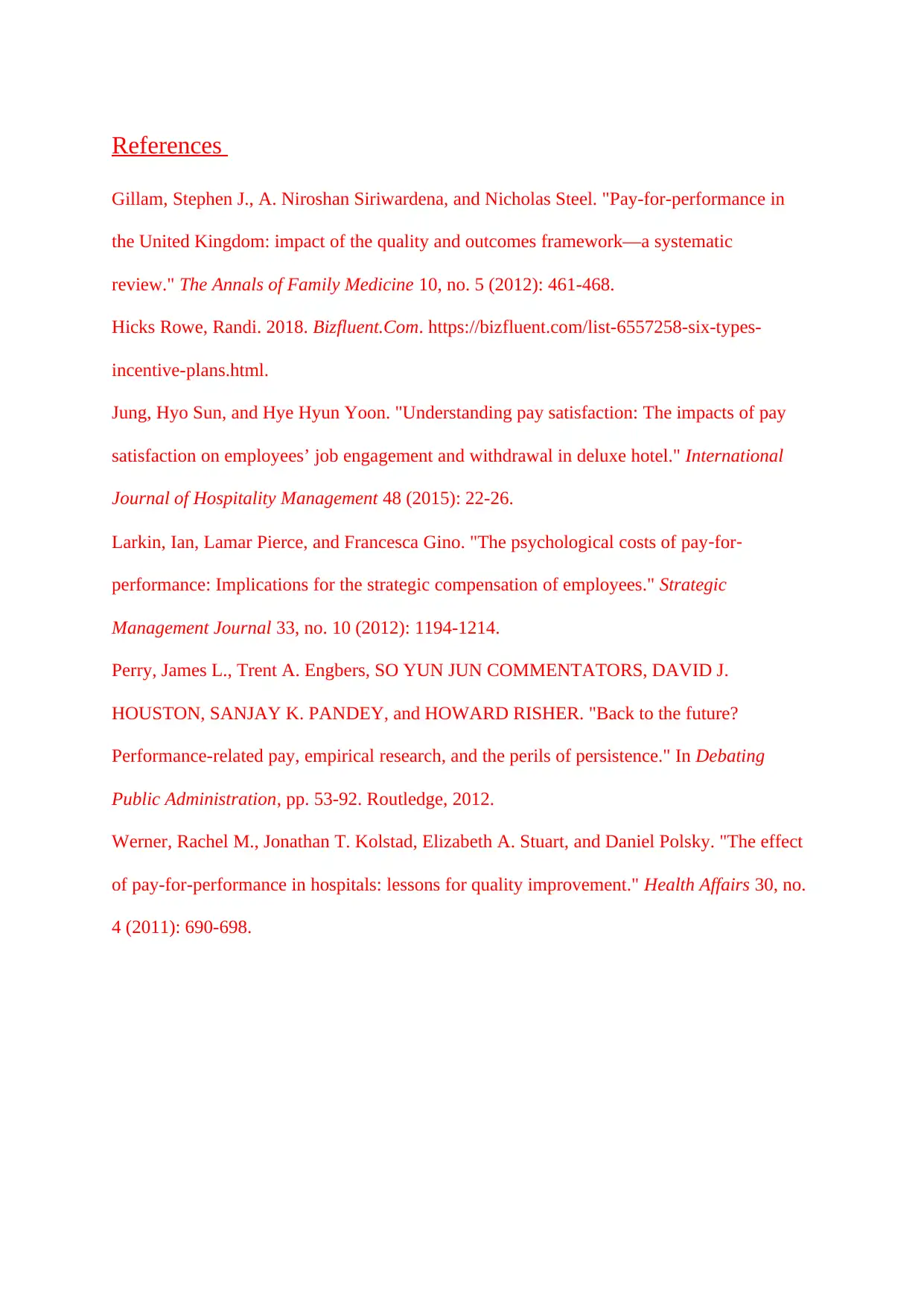
References
Gillam, Stephen J., A. Niroshan Siriwardena, and Nicholas Steel. "Pay-for-performance in
the United Kingdom: impact of the quality and outcomes framework—a systematic
review." The Annals of Family Medicine 10, no. 5 (2012): 461-468.
Hicks Rowe, Randi. 2018. Bizfluent.Com. https://bizfluent.com/list-6557258-six-types-
incentive-plans.html.
Jung, Hyo Sun, and Hye Hyun Yoon. "Understanding pay satisfaction: The impacts of pay
satisfaction on employees’ job engagement and withdrawal in deluxe hotel." International
Journal of Hospitality Management 48 (2015): 22-26.
Larkin, Ian, Lamar Pierce, and Francesca Gino. "The psychological costs of pay‐for‐
performance: Implications for the strategic compensation of employees." Strategic
Management Journal 33, no. 10 (2012): 1194-1214.
Perry, James L., Trent A. Engbers, SO YUN JUN COMMENTATORS, DAVID J.
HOUSTON, SANJAY K. PANDEY, and HOWARD RISHER. "Back to the future?
Performance-related pay, empirical research, and the perils of persistence." In Debating
Public Administration, pp. 53-92. Routledge, 2012.
Werner, Rachel M., Jonathan T. Kolstad, Elizabeth A. Stuart, and Daniel Polsky. "The effect
of pay-for-performance in hospitals: lessons for quality improvement." Health Affairs 30, no.
4 (2011): 690-698.
Gillam, Stephen J., A. Niroshan Siriwardena, and Nicholas Steel. "Pay-for-performance in
the United Kingdom: impact of the quality and outcomes framework—a systematic
review." The Annals of Family Medicine 10, no. 5 (2012): 461-468.
Hicks Rowe, Randi. 2018. Bizfluent.Com. https://bizfluent.com/list-6557258-six-types-
incentive-plans.html.
Jung, Hyo Sun, and Hye Hyun Yoon. "Understanding pay satisfaction: The impacts of pay
satisfaction on employees’ job engagement and withdrawal in deluxe hotel." International
Journal of Hospitality Management 48 (2015): 22-26.
Larkin, Ian, Lamar Pierce, and Francesca Gino. "The psychological costs of pay‐for‐
performance: Implications for the strategic compensation of employees." Strategic
Management Journal 33, no. 10 (2012): 1194-1214.
Perry, James L., Trent A. Engbers, SO YUN JUN COMMENTATORS, DAVID J.
HOUSTON, SANJAY K. PANDEY, and HOWARD RISHER. "Back to the future?
Performance-related pay, empirical research, and the perils of persistence." In Debating
Public Administration, pp. 53-92. Routledge, 2012.
Werner, Rachel M., Jonathan T. Kolstad, Elizabeth A. Stuart, and Daniel Polsky. "The effect
of pay-for-performance in hospitals: lessons for quality improvement." Health Affairs 30, no.
4 (2011): 690-698.
1 out of 8
Related Documents
Your All-in-One AI-Powered Toolkit for Academic Success.
+13062052269
info@desklib.com
Available 24*7 on WhatsApp / Email
![[object Object]](/_next/static/media/star-bottom.7253800d.svg)
Unlock your academic potential
Copyright © 2020–2025 A2Z Services. All Rights Reserved. Developed and managed by ZUCOL.





